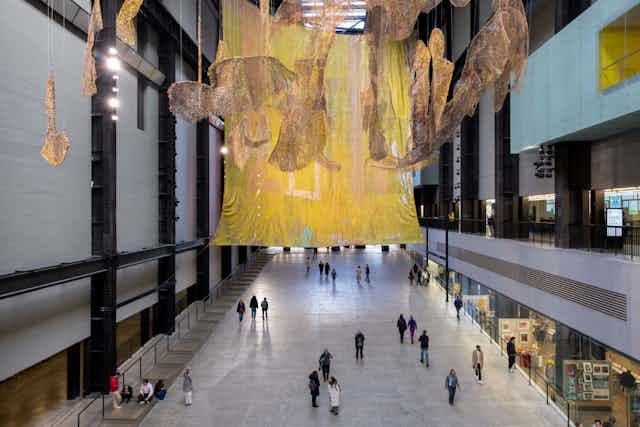The international art world is celebrating the Ghanaian artist El Anatsui in London. On 9 October, a gigantic installation of three new works – Behind the Red Moon – opened at the Turbine Hall at the prestigious Tate Modern, displaying what Anatsui is most famous for: unique, large scale sculptural hangings.
Read more: El Anatsui creates gigantic artworks from recycled materials - why the world fell in love with him
Behind the Red Moon is the 2023 Hyundai Commission, an annual exhibition where a globally important artist is invited to stage an installation at the gallery. The exhibition also kicked off the annual Frieze Week of art shows in the city staged to coincide with the Frieze Art Fair, a major international art event.
This and another two significant exhibitions by Anatsui are happening simultaneously in London.
Anatsui spent decades teaching sculpture and art education at the University of Nigeria in Nsukka. As an art lecturer in the same department I have followed and taught his work to students for years – as he once taught me. Along with other former students of his, I travelled to London to view Behind the Red Moon.
The Tate installation further cements the already considerable international reputation of the 79-year-old artist, who creates enormous sculptural pieces, normally from wood and recycled materials such as discarded bottle tops. It does so in a way that establishes a powerful conversation about how history is constructed by the coming together of many cultures in a capitalist world.
The Tate show
The opening of Behind the Red Moon was a cosmopolitan event. Many came from all continents to celebrate a master artist whose practice transcends race, generation and materials. Yet the opening night crowd presented an African flavour – the kind you see at very important events in Nigeria.
In an earlier article on Anatsui, I predicted that the artist “will take your breath away by the time he is done overtaking and mesmerising the massive hall”. Expect to be dazzled! Behind the Red Moon is a magical and troubling universe, shimmering with meanings.

The installation, curated by Tate Modern’s Osei Bonsu and Dina Akhmadeeva, is presented in three acts. The works are fashioned out of over three million used, flattened bottle caps woven together with copper coils to give them the visual appearance of fabrics. They resemble kente cloth from Ghana, the woven cloths of the Akwete in Nigeria and lace from the west.
Each of the three works has dual sides and viewers can choose which side to begin with. The three acts depict imaginary scenes that begin with a blood moon and sun and progress to the earth and to a dead and exploited ocean throwing up its beautiful aquatic life.
The three acts
Let me walk you through these staged acts. At the entrance a visitor is greeted by plaques of texts cast in red against black. They contain phrases that serve as a guide to the essence of the work. One, for example, reads: “Each material has its properties, physical and even spiritual.”

The artist dwells in the urgency of the present and the planet’s crisis by interrogating the past. The works progress from shining yellow to red to browns to blacks. They speak of the interaction between the global north and south as well as conflict, war, insecurity, climate emergencies and questions of human rights.
Act I: The red moon speaks of how capitalism has driven global connections between continents through waters and sails. The title Behind the Red Moon is instantly revealed on the flipside of the red sculpture – which shows a sunny, yellowy landscape.

Act II: Anatsui writes, on a plaque, that he uses “multiple elements to talk about the world: not a world made up of just one culture, but a world shaped by all of us coming together”. Multiple continents hang from the ceiling to reveal a round earth from a particular angle.
Again there is a poetic second meaning: its flipside reveals what looks like a collection of humanoids pulling on the earth, bringing it to its knees through human activities that have brought us misery in the form of climate and humanitarian crises.

Act III: Just beyond that is a work cast in dark shades on one side, dripping right onto the floor and flowing like a black veil. (This became the backdrop for a special performance by master Ghanaian drummer Abass Dodoo and One Drum that enlivened the opening, giving it the feel of an African festival.)
This black sculpture suggests black gold – crude oil, coal and other fossil fuels – extracted from the earth. There’s an urgency here, a call to a transition to renewable sources of energy.

The flipside is magnificence itself, rich gold colours and reds that could be speaking of the opulence of the west or, for that matter, greedy leaders in poor African countries. The ocean is blackened by them, poor and rich co-existing.
With Behind the Red Moon El Anatsui offers a big picture of history and civilisation – and warns of the consequences of capitalist greed. You will struggle not to be awed by the work.
Behind the Red Moon is on display at the Tate until 14 April 2024

